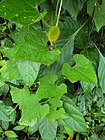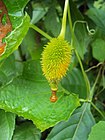Note: This is a project under development. The articles on this wiki are just being initiated and broadly incomplete. You can Help creating new pages.
Difference between revisions of "Momordica dioica"
| (One intermediate revision by the same user not shown) | |||
| Line 1: | Line 1: | ||
[[File:Momordica dioica (1129111386).jpg|thumb|right|'''Momordica dioica''']] | [[File:Momordica dioica (1129111386).jpg|thumb|right|'''Momordica dioica''']] | ||
| − | '''Momordica dioica''' | + | '''Momordica dioica''' is commonly known as spiny gourd or spine gourd and also known as bristly balsam pear. It is a species of flowering plant in the Bengali gourd family. It is used as a vegetable in all regions of India and some parts in South Asia. It has commercial importance and is exported and used locally. The fruits are cooked with spices,or fried and sometimes eaten with meat or fish. |
==Uses== | ==Uses== | ||
| − | {{Uses| | + | {{Uses|Diabetes}}. |
| + | |||
| + | ===Food=== | ||
| + | Momordica dioica can be used in Food. Tubersous roots and young green fruits are cooked as vegetable.<ref name="Forest foods of Western Ghat"/> | ||
==Parts Used== | ==Parts Used== | ||
| Line 12: | Line 15: | ||
==Common names== | ==Common names== | ||
| − | {{Common names|kn= | + | {{Common names|kn=Mada haagala kaayi ಮಡ ಹಾಗಲಕಾಯಿ|ml=|sa=Karkotaki, Karkoti|ta=Mezhuku-pakal, Pazhu-pakal|te=Boda kakara|hi=Kikoda|en=}} |
==Properties== | ==Properties== | ||
| Line 29: | Line 32: | ||
===Prabhava=== | ===Prabhava=== | ||
| + | |||
| + | ===Nutritional components=== | ||
| + | Momordica dioica Contains the Following nutritional components like - Vitamin-C, Thiamine (B1), Riboflavin (B2), Niacin (B3); β-carotene; Calcium, Copper, Iron, Potassium, Phosphorus, Sodium, Zinc<ref name="Forest foods of Western Ghat"/> | ||
==Habit== | ==Habit== | ||
| Line 35: | Line 41: | ||
==Identification== | ==Identification== | ||
===Leaf=== | ===Leaf=== | ||
| − | {{Leaf|Simple| | + | {{Leaf|Simple|Round|1.5-5.0 cm long, heart-shaped at base, hairless or sparsely hairy, middle lobes broadly ovate or rhombic-ovate}}<ref name="Leaf"/> |
===Flower=== | ===Flower=== | ||
| − | {{Flower|Bisexual| | + | {{Flower|Bisexual|Broadly ovate-heart-shaped|Yellowish||2.5-3.0 cm across, stalked. Male flowers are solitary, on 1.5 cm long flower-cluster-stalk, bearing near the tip a stalkless}} |
===Fruit=== | ===Fruit=== | ||
| − | {{Fruit|Simple Fruit| | + | {{Fruit|Simple Fruit|Ovoid|2-7 cm long, 1-2.5 cm broad|Orange-red|}} |
===Other features=== | ===Other features=== | ||
| Line 52: | Line 58: | ||
==How to plant/cultivate== | ==How to plant/cultivate== | ||
| − | Requires a soil rich in organic matter if optimum yields are to be achieved. A dioecious plant, male and female forms need to be grown if fruit and seed are required | + | Requires a soil rich in organic matter if optimum yields are to be achieved. A dioecious plant, male and female forms need to be grown if fruit and seed are required<ref name="How to plant/cultivate"/>. Momordica dioica is avilable through June to October<ref name="Forest foods of Western Ghat"/> |
| − | <ref name="How to plant/cultivate"/> | ||
==Commonly seen growing in areas== | ==Commonly seen growing in areas== | ||
| Line 67: | Line 72: | ||
==References== | ==References== | ||
| − | |||
<references> | <references> | ||
<ref name="chemical composition">[https://en.wikipedia.org/wiki/Momordica_dioica Chemical composition]</ref> | <ref name="chemical composition">[https://en.wikipedia.org/wiki/Momordica_dioica Chemical composition]</ref> | ||
| − | |||
<ref name="Leaf">[https://books.google.co.in/books?id=-mTUBjSyo_UC&pg=PA136&redir_esc=y#v=onepage&q&f=false Morphology]</ref> | <ref name="Leaf">[https://books.google.co.in/books?id=-mTUBjSyo_UC&pg=PA136&redir_esc=y#v=onepage&q&f=false Morphology]</ref> | ||
| − | |||
<ref name="How to plant/cultivate">[http://tropical.theferns.info/viewtropical.php?id=Momordica+dioica Cultivation Details]</ref> | <ref name="How to plant/cultivate">[http://tropical.theferns.info/viewtropical.php?id=Momordica+dioica Cultivation Details]</ref> | ||
| + | <ref name="Forest foods of Western Ghat">"Forest food for Northern region of Western Ghats" by Dr. Mandar N. Datar and Dr. Anuradha S. Upadhye, Page No.116, Published by Maharashtra Association for the Cultivation of Science (MACS) Agharkar Research Institute, Gopal Ganesh Agarkar Road, Pune</ref> | ||
</references> | </references> | ||
==External Links== | ==External Links== | ||
| − | * [https://books.google.co.in/books?id=-mTUBjSyo_UC&pg=PA136&redir_esc=y#v=onepage&q&f=false Momordica dioica] | + | * [https://books.google.co.in/books?id=-mTUBjSyo_UC&pg=PA136&redir_esc=y#v=onepage&q&f=false Momordica dioica on books.google.co.in] |
[[Category:Herbs]] | [[Category:Herbs]] | ||
[[Category:Cucurbitaceae]] | [[Category:Cucurbitaceae]] | ||
Latest revision as of 16:40, 12 November 2021
Momordica dioica is commonly known as spiny gourd or spine gourd and also known as bristly balsam pear. It is a species of flowering plant in the Bengali gourd family. It is used as a vegetable in all regions of India and some parts in South Asia. It has commercial importance and is exported and used locally. The fruits are cooked with spices,or fried and sometimes eaten with meat or fish.
Contents
- 1 Uses
- 2 Parts Used
- 3 Chemical Composition
- 4 Common names
- 5 Properties
- 6 Habit
- 7 Identification
- 8 List of Ayurvedic medicine in which the herb is used
- 9 Where to get the saplings
- 10 Mode of Propagation
- 11 How to plant/cultivate
- 12 Commonly seen growing in areas
- 13 Photo Gallery
- 14 References
- 15 External Links
Uses
Food
Momordica dioica can be used in Food. Tubersous roots and young green fruits are cooked as vegetable.[1]
Parts Used
Chemical Composition
Momordica dioica as the average nutritional value per 100 g edible fruit was found to contain 84.1% moisture, 7.7 g carbohydrate, 3.1 g protein, 3.1 g fat, 3.0 g fiber and 1.1 g minerals. [2]
Common names
| Language | Common name |
|---|---|
| Kannada | Mada haagala kaayi ಮಡ ಹಾಗಲಕಾಯಿ |
| Hindi | Kikoda |
| Malayalam | |
| Tamil | Mezhuku-pakal, Pazhu-pakal |
| Telugu | Boda kakara |
| Marathi | NA |
| Gujarathi | NA |
| Punjabi | NA |
| Kashmiri | NA |
| Sanskrit | Karkotaki, Karkoti |
| English |
Properties
Reference: Dravya - Substance, Rasa - Taste, Guna - Qualities, Veerya - Potency, Vipaka - Post-digesion effect, Karma - Pharmacological activity, Prabhava - Therepeutics.
Dravya
Rasa
Guna
Veerya
Vipaka
Karma
Prabhava
Nutritional components
Momordica dioica Contains the Following nutritional components like - Vitamin-C, Thiamine (B1), Riboflavin (B2), Niacin (B3); β-carotene; Calcium, Copper, Iron, Potassium, Phosphorus, Sodium, Zinc[1]
Habit
Identification
Leaf
| Kind | Shape | Feature |
|---|---|---|
| Simple | Round | 1.5-5.0 cm long, heart-shaped at base, hairless or sparsely hairy, middle lobes broadly ovate or rhombic-ovate |
Flower
| Type | Size | Color and composition | Stamen | More information |
|---|---|---|---|---|
| Bisexual | Broadly ovate-heart-shaped | Yellowish | 2.5-3.0 cm across, stalked. Male flowers are solitary, on 1.5 cm long flower-cluster-stalk, bearing near the tip a stalkless |
Fruit
| Type | Size | Mass | Appearance | Seeds | More information |
|---|---|---|---|---|---|
| Simple Fruit | Ovoid | 2-7 cm long, 1-2.5 cm broad | Orange-red | {{{6}}} |
Other features
List of Ayurvedic medicine in which the herb is used
Where to get the saplings
Mode of Propagation
How to plant/cultivate
Requires a soil rich in organic matter if optimum yields are to be achieved. A dioecious plant, male and female forms need to be grown if fruit and seed are required[4]. Momordica dioica is avilable through June to October[1]
Commonly seen growing in areas
Photo Gallery
References
- ↑ 1.0 1.1 1.2 "Forest food for Northern region of Western Ghats" by Dr. Mandar N. Datar and Dr. Anuradha S. Upadhye, Page No.116, Published by Maharashtra Association for the Cultivation of Science (MACS) Agharkar Research Institute, Gopal Ganesh Agarkar Road, Pune
- ↑ Chemical composition
- ↑ Morphology
- ↑ Cultivation Details
External Links
- Ayurvedic Herbs known to be helpful to treat Diabetes
- Herbs with Fruits used in medicine
- Herbs with Leaves used in medicine
- Herbs with Roots used in medicine
- Herbs with common name in Kannada
- Herbs with common name in Hindi
- Herbs with common name in Tamil
- Herbs with common name in Telugu
- Herbs with common name in Sanskrit
- Habit - Herbs
- Index of Plants which can be propagated by Seeds
- Herbs that are commonly seen in the region of Garden area
- Herbs
- Cucurbitaceae




